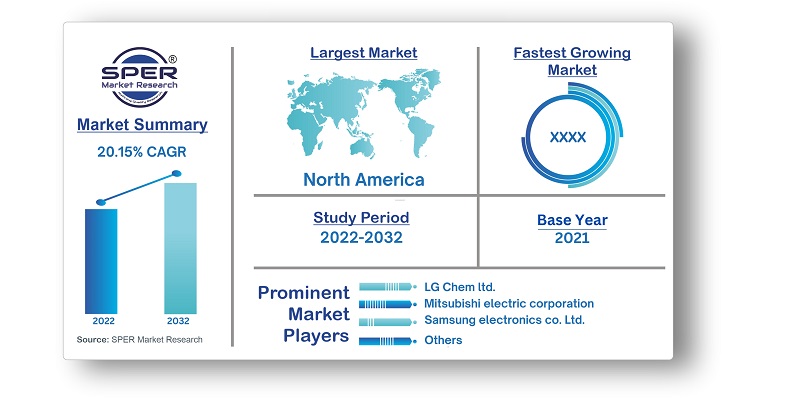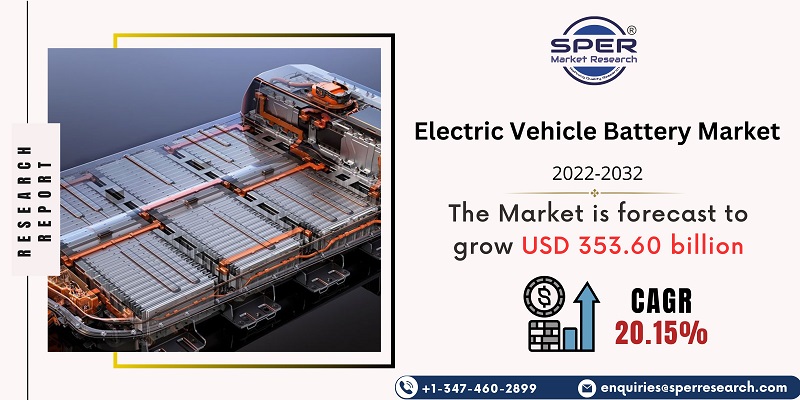
Electric Vehicle Battery Market Growth, Trends, Size, Revenue, Share, Challenges and Future Scope
Electric Vehicle Battery Market Size- By Propulsion Type, By Battery Type, By Vehicle Type- Regional Outlook, Competitive Strategies and Segment Forecasts to 2032
| Published: Feb-2023 | Report ID: AMIN2314 | Pages: 1 - 244 | Formats*: |
| Category : Automotive & Transportation | |||
- July 2022: Samsung SDI revealed its plan to invest $11 billion in cylindrical battery production lines in Malaysia. This investment aims to establish a cutting-edge EV battery production facility to cater to the increasing demand for electric vehicle batteries.
- September 2022: BYD introduced its blade batteries for commercial electric vehicles and unveiled its e-Bus Platform plan, starting in Europe. These Blade Batteries enhance safety and durability for BYD's EVs as it seeks to expand its global presence.


| Report Metric | Details |
| Market size available for years | 2019-2032 |
| Base year considered | 2021 |
| Forecast period | 2022-2032 |
| Segments covered | By Propulsion Type, By Battery Type, By Vehicle Type |
| Regions covered | Asia Pacific, Europe, Latin America, Middle East and Africa, North America |
| Companies Covered | Beijing pride power battery technology co ltd, BYD company limited (byd auto co., ltd.), Enersys (Quallion llc), GSR capital (automotive energy supply corporation), LG Chem ltd., Mitsubishi electric corporation, Panasonic corporation, Samsung electronics co. Ltd., Tianneng power international limited, Wanxiang group corporation |
Despite the automotive industry's downturn during the COVID-19 pandemic, the demand for electric vehicles (e-vehicles) continued to rise due to supportive government regulations globally. Even before the pandemic, many countries were strengthening policies like CO2 emissions standards and Zero-Emission Vehicle (ZEV) mandates. By 2021, more than 20 countries had announced bans on conventional car sales or mandated new sales to be Battery Electric Vehicles (BEVs). This growing e-vehicle demand during the pandemic boosted the global market. Furthermore, governments worldwide provided incentives and tax benefits, safeguarding the market from the economic downturn.
Key Target Audience:
- Automotive Manufacturers
- Battery Manufacturers
- Charging Infrastructure Providers
- Electric Vehicle Manufacturers
- End consumers purchasing electric vehicles
- Energy Storage Solutions Providers
- Environmental and Sustainability
- Investors and Financial Institutions
- Research and Development Institutions
- Others
| By Propulsion Type: |
|
| By Battery Type: |
|
| By Vehicle Type: |
|
- Global Electric Vehicle Battery Market Size (FY’2023-FY’2032)
- Overview of Global Electric Vehicle Battery Market
- Segmentation of Global EV Battery Market By Propulsion Type (Battery Electric Vehicle, Hybrid Electric Vehicle, Plug in Hybrid Electric Vehicle)
- Segmentation of Global EV Battery Market By Battery Type (Lead Acid Battery, Nickel Metal Hydride Battery, Lithium ion battery)
- Segmentation of Global EV Battery Market By Vehicle Type (Passenger Car, Commercial Vehicle, Two Wheeler)
- Statistical Snap of Global Electric Vehicle Battery Market
- Expansion Analysis of Global Electric Vehicle Battery Market
- Problems and Obstacles in Global Electric Vehicle Battery Market
- Competitive Landscape in the Global Electric Vehicle Battery Market
- Impact of COVID-19 and Demonetization on Global Electric Vehicle Battery Market
- Details on Current Investment in Global Electric Vehicle Battery Market
- Competitive Analysis of Global Electric Vehicle Battery Market
- Prominent Players in the Global Electric Vehicle Battery Market
- SWOT Analysis of Global Electric Vehicle Battery Market
- Global Electric Vehicle Battery Market Future Outlook and Projections (FY’2023-FY’2032)
- Recommendations from Analyst
1.1. Scope of the report1.2. Market segment analysis
2.1 Research data source
2.1.1 Secondary data2.1.2 Primary data2.1.3 SPER’s internal database2.1.4 Premium insight from KOL’s
2.2 Market size estimation
2.2.1 Top-down and Bottom-up approach
2.3 Data triangulation
4.1. Driver, Restraint, Opportunity and Challenges analysis
4.1.1 Drivers4.1.2 Restraints4.1.3 Opportunities4.1.4 Challenges
4.2. COVID-19 Impacts of the Global EV Battery Market
5.1. SWOT analysis
5.1.1 Strengths5.1.2 Weaknesses5.1.3 Opportunities5.1.4 Threats
5.2. PESTEL analysis
5.2.1 Political landscape5.2.2 Economic landscape5.2.3 Social landscape5.2.4 Technological landscape5.2.5 Environmental landscape5.2.6 Legal landscape
5.3. PORTER’S five forces analysis
5.3.1 Bargaining power of suppliers5.3.2 Bargaining power of Buyers5.3.3 Threat of Substitute5.3.4 Threat of new entrant5.3.5 Competitive rivalry
5.4. Heat map analysis
6.1 Global EV Battery Market Manufacturing Base Distribution, Sales Area, Product Type6.2 Mergers & Acquisitions, Partnerships, Product Launch, and Collaboration in Global EV Battery Market
7.1 Battery Electric Vehicle7.2 Hybrid Electric Vehicle7.3 Plug-in Hybrid Electric Vehicle
8.1 Lead Acid Battery8.2 Nickel Metal Hydride Battery8.3 Lithium-ion Battery
9.1 Passenger Car9.2 Commercial Vehicle9.3 Two-Wheeler
10.1 Global EV Battery Market Size and Market Share by Region (2019-2025)10.2 Global EV Battery Market Size and Market Share by Region (2026-2032)10.3 Asia-Pacific
10.3.1 China10.3.2 India10.3.3 Japan10.3.4 South Korea10.3.5 Rest of Asia-Pacific
10.4 Europe
10.4.1 France10.4.2 Germany10.4.3 Russia10.4.4 United Kingdom10.4.5 Rest of Europe
10.5 Latin America, Middle East, and Africa
10.5.1 Latin America10.5.2 Middle East10.5.3 Africa10.6 North America10.6.1 Canada10.6.2 Mexico
10.6.3 United States
11.1 Beijing Pride Power Battery Technology Co Ltd
11.1.1 Company details11.1.2 Financial outlook11.1.3 Product summary11.1.4 Recent developments
11.2 BYD Company Limited (BYD AUTO CO., LTD.)
11.2.1 Company details11.2.2 Financial outlook11.2.3 Product summary11.2.4 Recent developments
11.3 Enersys
11.3.1 Company details11.3.2 Financial outlook11.3.3 Product summary11.3.4 Recent development
11.4 LG Chem Ltd.
11.4.1 Company details11.4.2 Financial outlook11.4.3 Product summary11.4.4 Recent developments
11.5 Mitsubishi Electric Corporation
11.5.1 Company details11.5.2 Financial outlook11.5.3 Product summary11.5.4 Recent developments
11.6 Panasonic Corporation
11.6.1 Company details11.6.2 Financial outlook11.6.3 Product summary11.6.4 Recent developments
11.7 Samsung Electronics CO. LTD.
11.7.1 Company details11.7.2 Financial outlook11.7.3 Product summary11.7.4 Recent developments
11.8 Tianneng Power International Limited
11.8.1 Company details11.8.2 Financial outlook11.8.3 Product summary11.8.4 Recent developments
11.9 Wanxiang Group Corporation
11.9.1 Company details11.9.2 Financial outlook11.9.3 Product summary11.9.4 Recent development
SPER Market Research’s methodology uses great emphasis on primary research to ensure that the market intelligence insights are up to date, reliable and accurate. Primary interviews are done with players involved in each phase of a supply chain to analyze the market forecasting. The secondary research method is used to help you fully understand how the future markets and the spending patterns look likes.
The report is based on in-depth qualitative and quantitative analysis of the Product Market. The quantitative analysis involves the application of various projection and sampling techniques. The qualitative analysis involves primary interviews, surveys, and vendor briefings. The data gathered as a result of these processes are validated through experts opinion. Our research methodology entails an ideal mixture of primary and secondary initiatives.



Frequently Asked Questions About This Report
PLACE AN ORDER
Year End Discount
Sample Report
Pre-Purchase Inquiry
NEED CUSTOMIZATION?
Request CustomizationCALL OR EMAIL US
100% Secure Payment






Related Reports
Our Global Clients
Our data-driven insights have influenced the strategy of 200+ reputed companies across the globe.




















